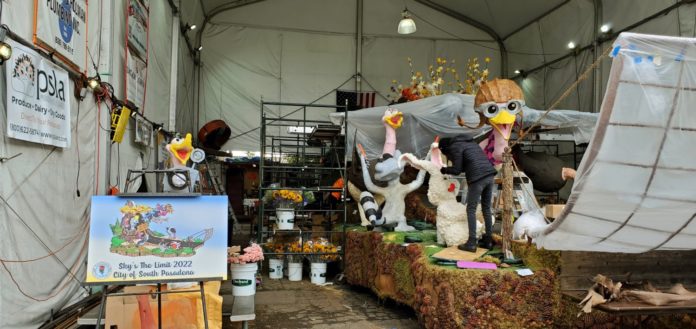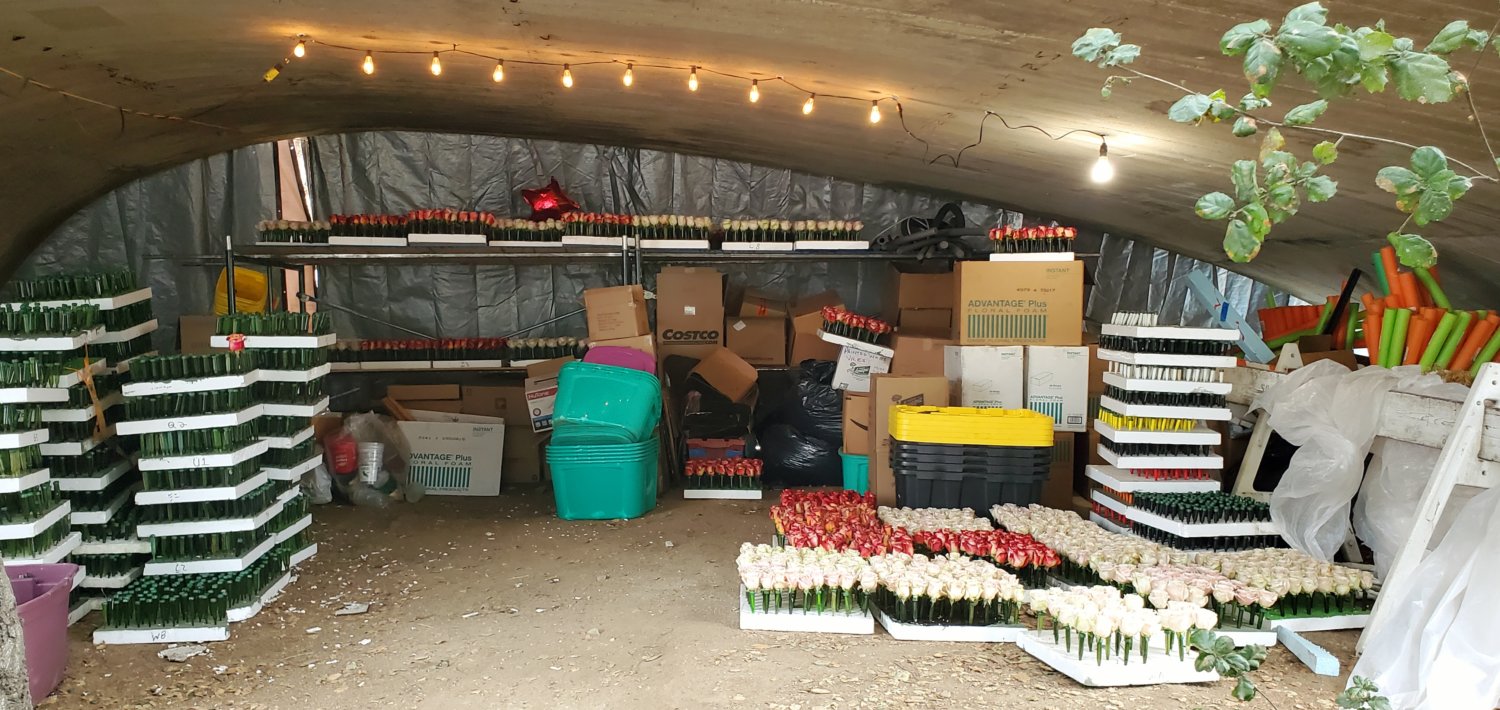
It was one man’s vision – a former mayor, civic leader and longtime resident many called “Mr. South Pasadena” – who first saw the day that a permanent structure was necessary to construct the city’s Rose Parade floats for generations to come.
That idea has been kicking around for 22 years.
“If it weren’t for Ted Shaw’s efforts, we may not be where we are today,” said Brant Dunlap, the current chair of the committee responsible for the float’s creation, remembering the impact Shaw made over the years before his passing in February 2020. “Ted, who meant so much to this city, wanted a permanent building more than anyone, coming up with the idea back in 2000.”
Finally, after all those years, Dunlap sees some positive signs that Shaw’s dream for a place to construct the city’s New Year’s Day floral masterpiece with four walls and a roof could someday come true.
Huge strides in that effort, insists Dunlap, were made last week by actions of the South Pasadena City Council to someday put a building in place, housing the float near the current outdoor work site at the War Memorial Building in the 400 block of Fair Oaks Avenue. Precisely, Dunlap said the proposed location for the new home would be north of the historic Oaklawn Bridge, between the War Memorial Building and nestled up against Metro fencing where Gold Line light rail trains pass daily.
At the end of a lengthy discussion during the September 7 meeting, the council agreed to obtain the preliminary title report of the proposed War Memorial site as well as perform a survey of the land to understand better if a float barn can be built at the location.
Traditionally, over the years, a workforce of volunteers have toiled on the float in preparation for the parade under a huge circus-like tent that is completely open, unsecured and a target for vandalism. Highly priced steel, tools and other byproducts of the city’s entry are often hoisted away, says Dunlap, at all hours of the day.

“We deal with the homeless, needles, feces, rats, and I told the council it needs to end or someday we may not have a float,” Dunlap stressed. “This is the year it has to happen. We have the council in place, a great float committee and the energy. If it does not happen now, the city is going to jeopardize losing the history of this float. This is the year. The time is now.”
The float’s presence in the parade has become a city institution since the day it first took part in the longstanding event back in 1893, three years after the Pasadena tradition all began. Today, South Pasadena has the oldest Rose Parade entry and is among six floats given the name “self-builts,” constructed entirely by a volunteers – the longest running in that category, too.
“We’re still here, and we’ve been doing it without a building for more than 130 years,” said Dunlap. “I hope we can finally get one.”
Overjoyed by what he calls a “great move by the city,” Dunlap said, “It was breathtaking to see what the council did for us. It was wonderful to see a group of people actually agree that something needs to be done. This is a strong indication that they want to see us survive.”
Within a couple of months after Shaw died, Dunlap and a small group, including Isabelle Greene of the famed Greene and Greene architectural family, were holding weekly Zoom meetings, brainstorming how to make a permanent building a reality. Her grandfather, Henry, and his brother, Charles, designed and built the Oaklawn Bridge and Waiting Station, both city landmarks, adjacent the War Memorial Building. In those early days with Shaw’s input, she came up with an original concept for what the permanent structure might look like.
While she provided a huge assist in the initial building concept, Greene will not take part in the project going forward, as Mark and Becky Smeaton of Crux Designs will take it from here, finalizing the building’s proposed design, which has not been released to the public. Internally, Dunlap, who was at Shaw’s hip over the years envisioning the project, monitors and discusses plans for future development with his float committee during monthly meetings at City Hall and through continued Zoom gatherings with a close-knit sub-group consisting of Sam Hernandez, the president of the South Pasadena Tournament of Roses Association; Alan Vlacich, who sits on the SPTOR board, and Mark Smeaton of Crux Designs.
All were in attendance at the recent council meeting when the pitch for the new building was made.
“We had everyone needed on our team to make this happen,” explained Dunlap, “and all we needed was for the council to say, ‘yes, we will work with you to help make it go forward,’ which is what we got. It was just a massive step.”
Dunlap likes the idea that the council will pay for both the primary title report and survey, and that it seemed acceptable to the idea of a new home for the float. “After we get that we’ll see if the foot fits into the shoe,” he said. “It was a huge victory. It was unanimous that something needs to be done by the city to assist us in putting up a building somewhere.”
If constructed at the War Memorial Building site, Dunlap estimates it will measure out approximately 35 feet wide, 60 feet long with a 25-foot ceiling. “If we build it there, you really won’t see it, because it will be located on the side of the existing building.”
Dunlap said among its features will be modern lighting and some old antique Craftsman décor to enhance its look.
Of course, the big task if the council ultimately gives its approval to build on city-owned land will be to pay for it, which falls into the hands of SPTOR.

“It’s going to take huge amounts of fundraising on our part,” said Dunlap. “With all that still needs to be accomplished regarding final approval, if everything goes smooth, it could be three years from now when that building is completed. We still need to have the Cultural Heritage Commission, preservation and the historical committee in town to look at it, and once council approves the concept of the building, then we need to go out and say, ‘how much is it going to cost?’ Then we have to go out and raise the money. We could be looking at $2 million. But, it’s exciting. It just allows us to do something we haven’t been able to do in 22 years.”
All councilmembers were present at the early September council meeting, with the exception of Diana Mahmud. “But the other four agreed it is time to consider the reasons and opportunity to put a permanent barn in place for the city float somewhere in the city,” said Dunlap. “And it was agreed to focus on the War Memorial Building site. They also agreed unanimously to provide us with a professional site plan, which gives typography, elevation, grade and actual dimensions of the lot.”
If the site at the War Memorial Building gets okayed, Dunlap says plans call for the SPTOR to restore an area once known as Oaklawn Park, now a parking lot where the tent housing the float now exists.
“We want to bring back the park like it once was to include the indigenous plants, brush, and make it beautiful,” said Dunlap. “As a city when we can say, ‘We’re going to do a development project – building for a float and rip out asphalt and build a park – that’s pretty good. No one is building parks in their cities nowadays. It’s crazy to be an established town from 1888 and say we’re going to build a park.’ We’re really proud of that entire separate project away from the permanent building to construct future floats. We’re going to bring an original park back to the community. I think that is pretty special.”
Following the council meeting which helped dictate the future of work on the float, Dunlap called Janet Benjamin, the daughter of Shaw and decoration chair on SPTOR committee, and told her “when you go to bed tonight, tell your dad he just took one step forward.”
Benjamin inquired, “What do you mean?” after which Dunlap answered, “We just got the approval to go to the next step. That’s something he never got. I told her congratulations, and thank you Ted for your vision.”
Hearing Dunlap begin to laugh, Benjamin responded, “He probably already knows. He was watching you guys the whole time.”















.png)






